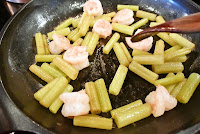A light fuki dish with shrimp that tastes gently salty and sweet. A recent hit among dishes I made for bento.
1/2 of recipe:
64 calories; 7.8 g protein; 2.1 g fat; 1.9 g carbohydrate; 1.1 g net carbs; 140 mg sodium (with 50% reduced-sodium soy sauce; 179 mg with regular soy sauce); 62 mg cholesterol; 0.8 g fiber
<Ingredients>
3-4 stalks (approx. 150 g) fuki Japanese butterbur (154 g prep-prboiled in photo; stalks cut in half)
8 medium shrimp (98 g in shell)
2-3 tsp katakuriko potato starch (to clean shrimp; not in photo)
For seasoning
1/2 tbsp sake
1/2 tbsp dashi
1/4 tsp rice vinegar
1/4 tsp shiokoji salted rice malt
1/2 tsp soy sauce
1 tsp oil (not in photo)
<Directions>
1.
Shell, clean with potato starch, rinse, and drain well.
2.
Cut fuki into 3-4 cm.
3.
Heat oil, and saute fuki on medium heat.
When fuki is coated with oil, add shrimp and flip when lower part turns opaque.
4.
Add all seasonings other than soy sauce, and mix well.
Transfer shrimp to a plate or bowl.
5.
Add soy sauce to fuki, and mix well.
6.
When liquid is almost gone, put back shrimp, and mix well.
Cook until liquid is gone and fuki or shrimp almost sticks to the pan.
Ready to serve.
<Notes>
1/2 of recipe:
64 calories; 7.8 g protein; 2.1 g fat; 1.9 g carbohydrate; 1.1 g net carbs; 140 mg sodium (with 50% reduced-sodium soy sauce; 179 mg with regular soy sauce); 62 mg cholesterol; 0.8 g fiber
<Ingredients>
8 medium shrimp (98 g in shell)
2-3 tsp katakuriko potato starch (to clean shrimp; not in photo)
For seasoning
1/2 tbsp sake
1/2 tbsp dashi
1/4 tsp rice vinegar
1/4 tsp shiokoji salted rice malt
1/2 tsp soy sauce
1 tsp oil (not in photo)
<Directions>
1.
Shell, clean with potato starch, rinse, and drain well.
2.
Cut fuki into 3-4 cm.
3.
Heat oil, and saute fuki on medium heat.
When fuki is coated with oil, add shrimp and flip when lower part turns opaque.
4.
Add all seasonings other than soy sauce, and mix well.
5.
Add soy sauce to fuki, and mix well.
6.
When liquid is almost gone, put back shrimp, and mix well.
Cook until liquid is gone and fuki or shrimp almost sticks to the pan.
Ready to serve.
<Notes>
- If using deveined (easy-peel) frozen shrimp, thaw and desalinate them in salted water (water should be less salty than seawater); this draws out the salt from shrimp. In addition to a negative impact on overall sodium intake, clearly salty shrimp ruin the balance of flavor in the final dish.
- In order to keep the color of shrimp, soy sauce is added only to fuki, and cooked shrimp is then returned to the pan. If color is not a concern, transferring shrimp to a plate or bowl is optional.
- If shiokoji is not at hand, use a tiny amount of salt and replace half of sake with mirin (or tiny amount of sugar), as shiokoji is both salty and sweet.
- First sauteing shrimp shells until pink and crispy (and then discarding) would impart a stronger shrimp aroma to the final dish.
- Cooking with oil is one way to keep the dish in good condition for later consumption (such as bento lunch) without depending on strong flavoring, even in warm weather. Vinegar and shiokoji also work as great food preservatives.















No comments:
Post a Comment